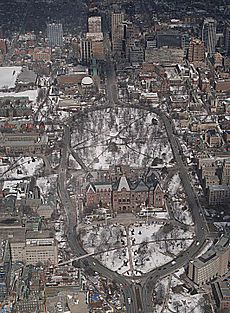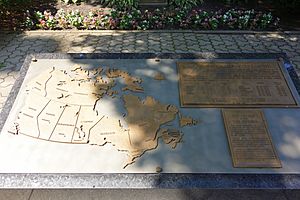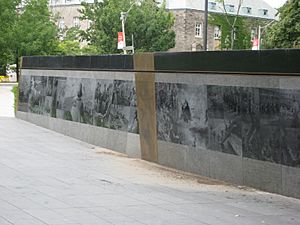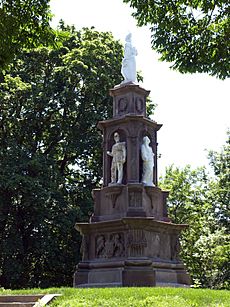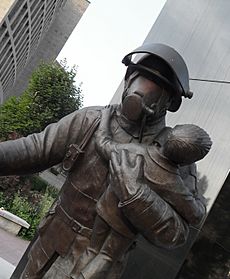Queen's Park (Toronto) facts for kids
Quick facts for kids Queen's Park |
|
|---|---|
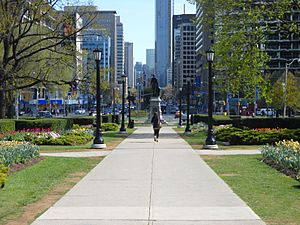
View from south of the Ontario Legislative Building towards University Avenue
|
|
| Type | Municipal park |
| Location | Toronto, Ontario, Canada |
| Etymology | Queen Victoria |
| Owned by | University of Toronto & Government of Ontario |
| Managed by | Toronto Parks, Forestry and Recreation Division & the Government of Ontario |
| Paths | 3 bicycle trails |
| Public transit access | |
Queen's Park is a well-known urban park in Downtown Toronto, Ontario, Canada. It was officially opened in 1860 by Edward, Prince of Wales. The park was named to honour Queen Victoria.
Today, Queen's Park is home to the Ontario Legislative Building. This building is where the Legislative Assembly of Ontario meets. Because of this, "Queen's Park" is often used to mean the Government of Ontario itself.
The park is almost completely surrounded by the University of Toronto. The university owns most of the land nearby. In 1859, the University of Toronto leased the park land to the City of Toronto government. This lease was for a very long time – 999 years! Later, in 1880, a part of the park was given to the Government of Ontario. This was so they could build new government buildings there. The land where the Legislative Assembly of Ontario stands is now owned by the provincial government. The northern part of the park is still owned by the University of Toronto but leased to the city.
Contents
Park History
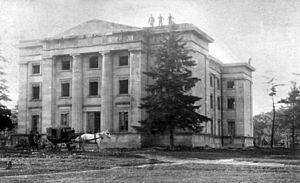
The story of Queen's Park began in 1827. That's when King's College, which later became the University of Toronto, bought a large piece of land. This land was north of what was then the Town of York (now Toronto). It included the area where Queen's Park is now.
In 1842, the first stone was laid for one of the college's early buildings. This building was finished in 1843. It was located where the east wing of the Ontario Legislative Building is today. The college called this area University Park.
In 1853, the government of the Province of Canada took over the building for their own use. The University of Toronto then moved its classes to a different location.
Becoming a Public Park
The park was very popular with local people. So, the municipal government of Toronto talked with the university about leasing the land. They wanted to make it a public park. In 1858, they signed a 999-year lease for the land. The agreement also said that the government could build a legislative building there if they wanted to.
On September 11, 1860, the park was officially opened. It became Canada's first municipal park. Edward, Prince of Wales, who later became King Edward VII, dedicated it. He named it Queen's Park to honour Queen Victoria. The Prince also laid a stone for a future statue of Queen Victoria. However, money problems meant a statue of Sir John A. Macdonald, Canada's first prime minister, was placed there instead. The statue of Victoria was finally bought and placed near the legislative building in 1902.
Building the Legislature
In 1879, the provincial government decided to build a new legislature on the park land. Construction was delayed for a while. Finally, the design was chosen in 1886. That same year, the southern part of the park was officially given to the provincial government.
The Ontario Legislative Building was finished in 1892. The first government meeting was held there in April 1893. After the building was done, some Russian cannons were moved to its entrance. These cannons were prizes captured by British forces during the Crimean War. Queen Victoria had given them to Toronto in 1859.
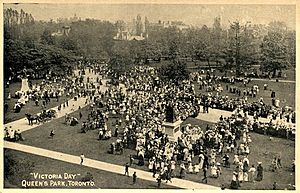
Even with the new building, the park remained a popular spot. People gathered there for concerts, special services, military parades, and political meetings. In the late 1800s, the northern part of Queen's Park also had a public speaking area on Sundays. During the First World War, the park was a meeting point for soldiers.
Recent History
In 1984, two eastern white pine trees were planted in the park. This happened after the eastern white pine was named Ontario's official tree. One tree was planted by Bob Welch, the deputy premier, for Arbor Day. Later that year, Queen Elizabeth II and the Duke of Edinburgh planted two more eastern white pines. A plaque marks the spot where these trees were planted.
In the early 2000s, a campaign started to put a statue of Canadian poet Al Purdy in Queen's Park. The idea was to show how important poetry and art are to Canada. The statue was unveiled in 2008. It was the first statue in Queen's Park to honour someone who was not a political leader or a monarch.
Park Layout
Queen's Park has an oval shape. The southwestern edge of the park has a slight "kink." This "kink" was formed by the old bank of Taddle Creek, a stream that now flows underground. The park is surrounded by Queen's Park Crescent East and West. These roads are part of a main route that includes University Avenue and Avenue Road.
Queen's Park Crescent East carries traffic going north, and Queen's Park Crescent West carries traffic going south. They form a loop around the park. University Avenue, Queen's Park (the street), and Avenue Road are straight and have two-way traffic. Wellesley Street cuts across Queen's Park Crescent, dividing the park into two main parts.
Northern Section
The part of the park north of Wellesley Street is managed by the Toronto Parks, Forestry and Recreation Division. It has many benches and picnic tables. This section looks like a traditional British park, with large trees that provide lots of shade in summer.
Paths spread out from a statue of King Edward VII on horseback. This statue stands on a large mound in the middle of the northern section. The main path runs between this statue and a war memorial for the 48th Highlanders of Canada at the very north end of the park. The north section of Queen's Park is also where gun salutes are fired for special events. These include Victoria Day, Canada Day, and Remembrance Day.
Southern Section
The part of Queen's Park south of Wellesley Street is managed by the provincial government. This section includes the Ontario Legislative Building, its parking lot, and the rest of the park. This area has less natural landscaping compared to the northern part.
However, the southern section has most of the park's monuments and memorials. It also features the Queen Elizabeth II rose gardens. The first part of the rose gardens was created in 1977 to celebrate Queen Elizabeth II's 25 years on the throne (her Silver Jubilee). An extension was added in 2003 for her 50th anniversary (her Golden Jubilee).
This part of the park also has the "White Trillium Garden." This garden is filled with white trilliums, which are Ontario's official flower. There's also a garden with plants native to the area. These include eastern white cedars, hackberries, and various perennial flowers. At the very southern tip of the park, facing University Avenue, is a statue of Sir John A. Macdonald.
Park Geography
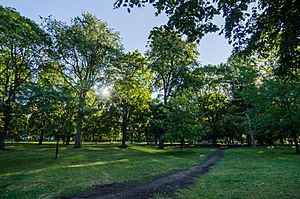
Queen's Park sits on sandy soil. This sand was left behind when the area was the bottom of a large ancient lake called Glacial Lake Iroquois. Originally, the area was covered with eastern white pine, northern red oak, and white oak trees.
However, many trees from Europe were planted in the early 1800s. Because of this, the park now has a wide variety of trees, both native to Toronto and from other parts of the world. Efforts are being made to plant more native trees to make the park look more like it did originally.
Getting There by Transit
The Line 1 Yonge-University of the Toronto subway runs underneath the park. You can get to Queen's Park using the Queen's Park and Museum subway stations. Other public transit options include the 5 Avenue Road and 94 Wellesley bus routes, and the 506 Carlton streetcar route.
Memorials and Statues
Queen's Park is home to many monuments and war memorials. These were built to remember important events or people. Most of them were put up in the late 1800s and early 1900s. However, some newer memorials have been added in the late 1900s and early 2000s. The monuments come in different forms, including statues of people. Some memorials are also located just outside the park.
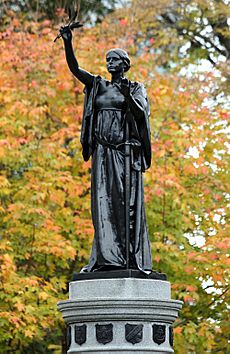
The first monument in Queen's Park was the Canadian Volunteer Memorial. It was unveiled in 1870 and is the second oldest monument in Toronto. This monument honours Toronto residents who fought in the Battle of Ridgeway.
Another war memorial was put up in 1895. This was the North-West Rebellion Monument. It remembers members of the Canadian Militia and the North-West Mounted Police who fought in that conflict. The monument has a 2.1-meter (7-foot) tall bronze statue of peace. She holds an olive branch and has a sword. The statue sits on a 3.7-meter (12-foot) white granite base. Cannonballs are placed at the corners of the base. The names of battles and soldiers who died are listed on the memorial. Walter Seymour Allward sculpted this monument.
Near the northern tip of Queen's Park is the 48th Highlanders Regimental Memorial, built in 1923. This memorial is a 12-meter (39-foot) high white granite pillar. It lists the battles the regiment fought in the Second Boer War, the First World War, and the Second World War.
In 1940, the Mackenzie monument was unveiled. It honours William Lyon Mackenzie and the start of responsible government in the Province of Canada. The monument has a bust (head and shoulders) of Mackenzie. Behind it is a bronze scene that tells a story. This monument was also sculpted by Walter Seymour Allward.
In 1967, the government of Ontario unveiled the Post One Monument. This monument celebrates Canada's 100th birthday. It is a stainless-steel plate with a bronze map of Canada on it. Similar monuments are in other Canadian provincial capitals. This monument also contains a time capsule that will be opened in 2067.
The Ontario Veterans’ Memorial was unveiled in 2006. It remembers Ontarians who served in the Canadian military from the time of Canadian Confederation until today. The monument is a 30-meter (98-foot) long granite wall. It has 44 images showing Canada's military history. These images include conflicts like the Fenian raids, North-West Rebellion, Second Boer War, First World War, Second World War, Korean War, and peacekeeping missions. A plaque nearby tells a brief history of Ontario's military involvement.
Near the southern tip of the park, there are two plaques on large rocks. One rock, placed in 1935, remembers King George V's 25 years on the throne. The second rock is a memorial for the victims of the Air India Flight 182 bombing in 1985. Another large rock with a plaque remembers Canadian volunteers who fought in the Spanish Civil War.
Statues of People
Queen's Park also has many full-body statues that honour important people. Most of these statues are on tall bases. Many of the statues in the southern part of the park face away from the legislative building, looking south.
| Person | Picture | Statue | Notes |
|---|---|---|---|
| George Brown |  |
 |
Made by Charles Bell Birch, unveiled in 1884. This was the first statue in the park to honour a historical figure. |
| King Edward VII |  |
 |
Made by Thomas Brock for an event in India in 1911. It was moved to Toronto in 1969. |
| Sir John A. Macdonald |  |
 |
Made by Hamilton MacCarthy, unveiled in 1894. |
| John Sandfield Macdonald |  |
 |
Made by Walter Seymour Allward, unveiled in 1909. |
| Sir Oliver Mowat |  |
 |
Made by Walter Seymour Allward, unveiled in 1905. |
| Al Purdy | Made by Edwin and Veronica Dam de Nogales, unveiled in 2008. | ||
| John Graves Simcoe |  |
 |
Made by Walter Seymour Allward, unveiled in 1903. |
| Queen Victoria |  |
 |
Purchased by Ontario in 1902. It was planned in 1860 but faced delays and money issues. It was finally put up in 1903 after Victoria's death. |
| Sir James Whitney |  |
 |
Made by Hamilton MacCarthy, unveiled in 1927. It uses limestone, dolomite, and marble to show Ontario's natural resources. |
Memorials Near the Park
Several monuments are built next to Queen's Park, separated by the roads that go around the park. The Canadian Volunteers Memorial is now west of Queen's Park Crescent West. It was originally inside the park but was separated when the road was built. This monument is 9 meters (30 feet) tall and has a square sandstone base with detailed carvings. On top is a marble statue of Britannia.
Three monuments have been built by the Ontario government near the southern part of Queen's Park. In 2000, the Ontario Police Memorial was dedicated. It honours police officers who died while serving their community. The memorial shows two police officers and lists the names of officers who died in Ontario.
A similar memorial, the Ontario Firefighter Memorial, was unveiled in 2005. It honours firefighters who died while on duty. The memorial shows a firefighter rescuing a child. It has a red base shaped like a Maltese Cross, which is a symbol for firefighting. It also lists the names of fallen firefighters.
The Notre Place monument celebrates the Franco-Ontarian community. It also honours the contributions that French-speaking people have made to Ontario. Work on the monument began in 2017 and it was unveiled in 2018. The stainless steel columns represent the Franco-Ontarian contributions to the province's forestry industry. The area around it is a gathering space. The monument's name, Notre Place, means "Our Place" and refers to a song. The Franco-Ontarian flag is also on the stone wall bench around the square.


